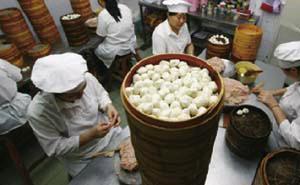For the Love of Food
2016-01-27ByMaraLeeDurrell
By+Mara+Lee+Durrell

It is sometimes hard for foreigners in China to express to their friends and family back home what exactly it is about their host country that keeps them so fascinated. But whether it is the endless array of jiaozi (dumplings), hot pot nights with friends or the tea traditions that instantly put you at ease, I would bet Chinas food culture is at the top of many peoples list.
As a newcomer, I realized early on that unraveling the social norms around eating would help me better connect with the country and its people. I also recognized that even beginning to understand a countrys food culture requires far more than consuming it, though I had plans to do plenty of that. I decided I would need to try cooking it myself.
So seven weeks after first arriving in Beijing, there I was, heading to Sichuan and Yunnan provinces in southwest China to get a taste of the Middle Kingdom outside of its capital city.
Upon take-off, I even thought that I knew something about Sichuan cuisine, as there are several restaurants purporting to serve this style of food in my home state of California. I know now that what I was served was miles away from the authentic versions.
The course started with us being split into small groups and given a shopping list, a traditional basket for market jaunts and a firm budget of 100 yuan ($15). Off we went, encour- aged by our guides to barter, with me using my very elementary Mandarin skills, meant to aid my team, who were in the country for just one week. We came back with full baskets and a strange sense of accomplishment, ready to prepare a feast for the whole group to consume.
Luckily my group was assigned my personal favorite Sichuan dish—and the one I was most eagerly looking forward to replicating—mapo doufu, a spicy tofu dish. I learned to quickly boil the tofu in hot water before adding it to the stirfry so the perfect tofu squares do not break, and the appropriate number of Sichuan numbing peppers to add to balance out the notorious chilies that are the regions signature ingredient. As a former vegetarian, this was a go-to dish for me at Chinese restaurants in the United States. I learned, however, that most chefs here add pork or beef to top off the dish and to add extra flavor.
Abandoning my dietary preferences was also a must for the xiaolongbao (soup dumplings) course I recently took in Beijing at The Hutong, an organization running daily cooking classes, market tours and other cultural excursions from a beautiful courtyard in Dongcheng District.
A friend visited from New York and we decided to do a cooking course together while she was in town. We thought the dish would be both challenging and fun to make, unaware the only choice for its filling is pork, an ingredient neither of us had ever cooked with. When this was explained by the head chef, my friend with a worried look on her face whispered to me she had never actually eaten pork. “When in Beijing!”we said, laughing anxiously.
Our first task was easy enough: Patiently stir flour, salt and water together in one direction to make the dough for the dumplings. After rolling these out to the intended thickness, size and shape, we were again given a false sense of confidence by our teacher.
We were then given bowls of raw meat to stir gently with chopsticks, adding intermittent spoonfuls of water to fluff it up, as the fat would absorb the liquid. Spring onions, soy sauce and ginger were added to provide additional flavor and remove any “gaminess” from the meat. Not the healthiest of choices on our part we realized, nor did we know how close we would get with the final product.
For those who dont know, the “soup” part of xiaolongbao is a refrigerated cube of fatty pork skin stock pre-made the day before. When the dumplings are steamed, the stock melts inside to provide the liquid consistency.
Our final task was to take the dough, add a“healthy” dose of the pork mixture, along with the small stock cubes and try to skillfully twist the dough into what almost looked like a gift. This brought on class-wide bouts of laughing, sighs and excited exclamations when we somewhat succeeded.
Then, of course, the best part was eating the dumplings straight out of the steamer. My friend Jamie is convinced that she ate about 15 before even looking up. So much for our vegetarian lifestyles—Chinese cuisine had obviously gotten the best of us.
